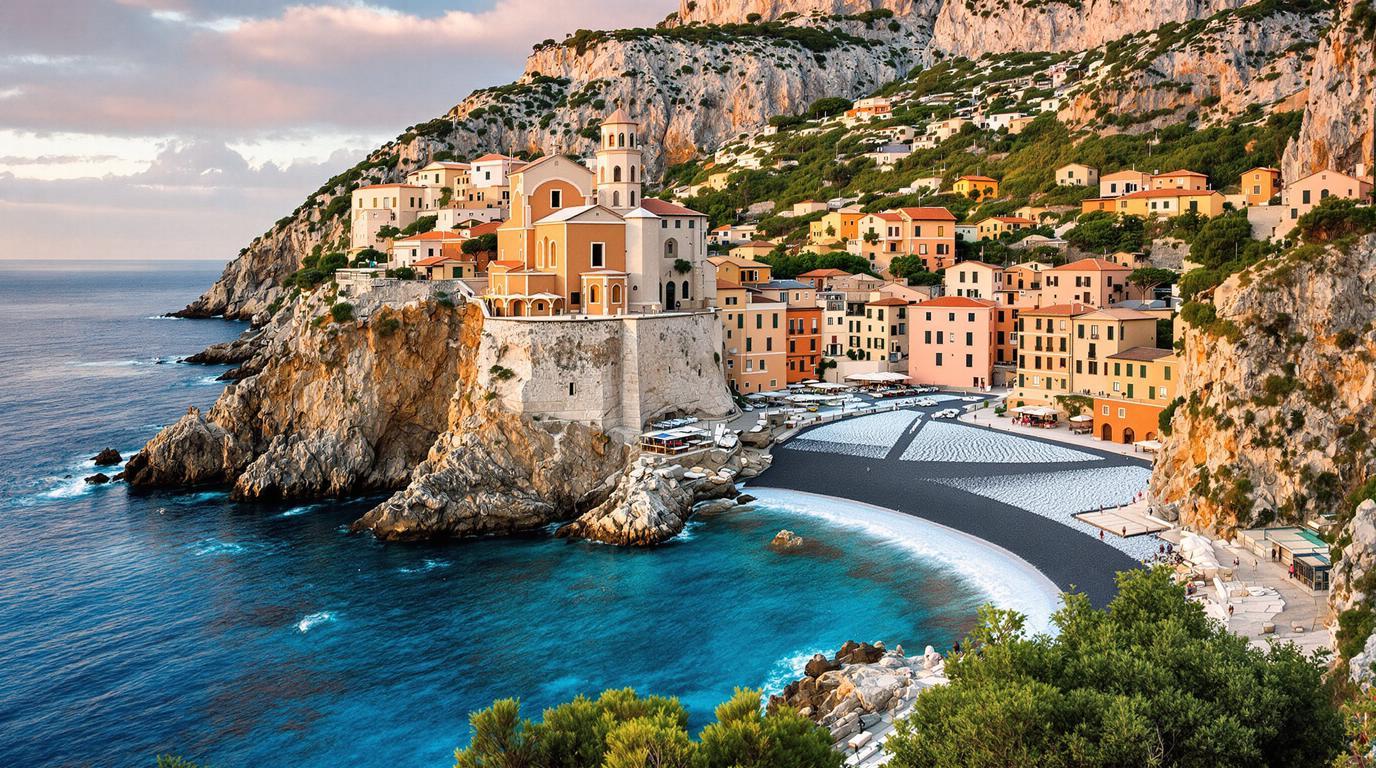Tucked away on the northern tip of Corsica’s Cap Corse peninsula, Nonza defies expectations. This dramatic clifftop village, voted France’s favorite village in 2016, perches precariously over a unique black-pebble beach that appears almost otherworldly against the Mediterranean’s brilliant turquoise waters.
A village suspended between sky and sea
Nonza’s position is nothing short of spectacular. The village clings to vertiginous cliffs rising 155 meters above the sea, creating a visual drama that rivals France’s other geological marvels. Despite housing only 75 year-round residents, this miniature settlement packs extraordinary cultural and natural treasures into its compact boundaries.
The enigmatic black beach phenomenon
Perhaps Nonza’s most striking feature is its beach – a sweeping crescent of jet-black pebbles that appears almost lunar against the azure Mediterranean. The unusual coloration comes from asbestos mining waste from a nearby factory in Canari, nature transforming industrial remnants into something unexpectedly beautiful.
“Our black beach is constantly changing. Visitors create ephemeral art by arranging white stones against the dark canvas – messages that disappear with each tide,” explains Marie Santini, a local cafe owner.
A tower that defied Napoleon
Standing sentinel over the village, the Torra di Nonza (Paoline Tower) dates to 1760 when Corsican independence leader Pascal Paoli commissioned it for coastal defense. This square watchtower offers breathtaking panoramic views of the Gulf of Saint-Florent and the dramatic rock formation known locally as “Trou du Diable” (Devil’s Hole).
The tower’s historical significance extends beyond its views – it successfully repelled both Barbary pirates and French forces, becoming a symbol of Corsican resilience that rivals structures found on other European islands with rich defensive histories.
Sacred orange: The church of Sainte Julie
The 16th-century Église Sainte Julie commands attention with its striking orange-pink façade that contrasts dramatically with Nonza’s predominantly white stone buildings. Inside, painted ceilings and a carefully preserved altar house relics of Saint Julie, a Roman-era martyr executed for her faith.
“The church’s color was chosen to be visible to fishermen returning from sea – a beacon of hope and safety,” notes historian Jean-Pierre Luciani.
Culinary cliffhangers
Dining in Nonza delivers both gastronomic and visual splendor. La Sassa restaurant offers tables perched dizzyingly over the cliff edge, serving fresh seafood caught that morning. The combination of locally-harvested sea urchins, Corsican wines, and that infinite blue horizon creates a sensory experience similar to other hidden culinary gems in France’s natural landscapes.
The path less traveled
The descent to Nonza’s beach requires navigating a steep path with numerous steps – a journey that deters casual tourists but rewards the determined. The physical challenge mirrors those found in other remarkable destinations where effort unlocks extraordinary rewards.
Early morning visitors might have this extraordinary landscape entirely to themselves – a rare privilege in an increasingly crowded Mediterranean.
Photographic paradise
Photographers flock to Nonza for its extraordinary light and dramatic contrasts. Sunset transforms the village into a golden spectacle, while the interplay of black beach, white village, and blue sea creates compositions reminiscent of the striking color contrasts found in Greece’s most picturesque islands.
The “Trou du Diable” rock formation creates natural frames for photographers patient enough to capture waves crashing through its natural arch.
When to embrace Nonza’s magic
May through September offers ideal conditions, though July and August bring crowds. Early June provides perfect temperatures, calm seas, and relative tranquility. Parking challenges make early arrival essential during peak season.
As Mediterranean sunlight bathes Nonza’s ancient stones in golden light each evening, visitors understand why this precipitous village captures hearts. In a world of overtourism, Nonza remains an authentic treasure – demanding effort but rewarding the journey with moments of transcendent beauty that linger long after you’ve left its clifftop perch.
